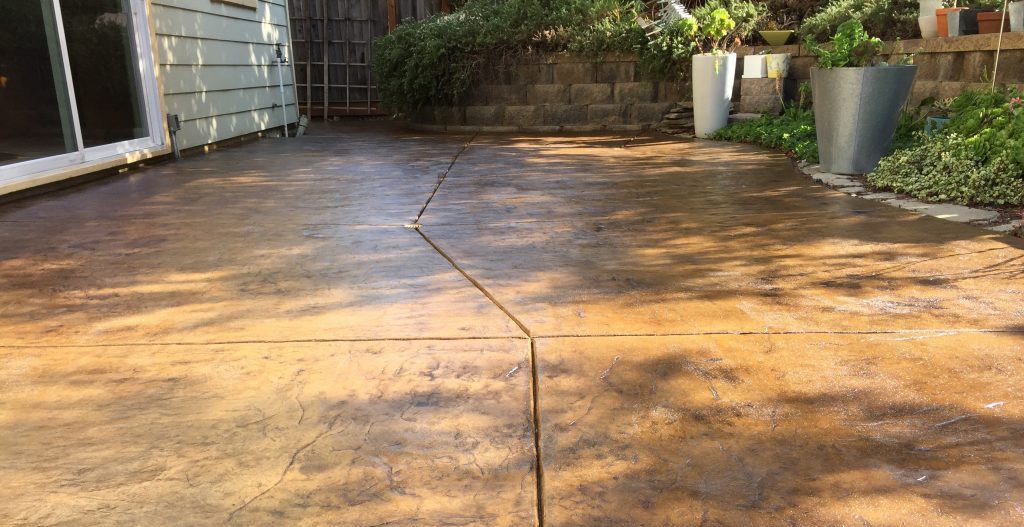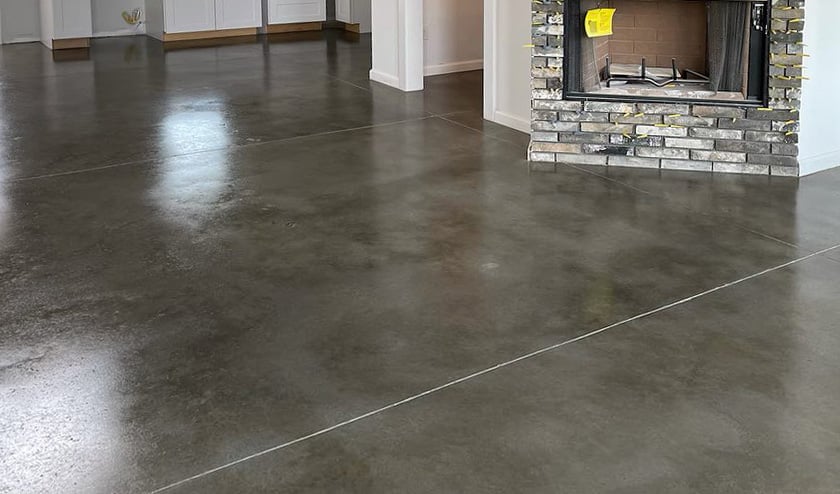The benefits of stained concrete for patios
Everything About Stained Concrete: A Comprehensive Guide to Its Advantages and Applications
Stained concrete has emerged as a preferred option for both property and business areas. Its capability to incorporate visual appeal with functionality makes it a fascinating alternative. Numerous staining strategies supply a series of colors and surfaces, enabling customization. However, the advantages extend past look. Understanding its applications and upkeep needs is important for any person considering this versatile material. The subtleties of stained concrete invite further exploration.
What Is Stained Concrete?

Staining can be applied to different surface areas, including floorings, driveways, and patios, making it a functional option for both indoor and exterior spaces. The therapy can attain a series of looks, from earthy tones to bold, modern-day layouts. Unlike paint, stained concrete maintains its look in time, as it becomes an integral part of the concrete itself. In general, stained concrete offers as an effective method for transforming normal concrete right into aesthetically striking surfaces.
Benefits of Stained Concrete
Stained concrete offers substantial advantages, especially in aesthetic allure and durability - local stained concrete. Its vibrant colors and distinct patterns boost the aesthetic charm of any kind of space, making it a preferred selection for both household and business applications. Furthermore, the longevity of stained concrete warranties that it stays a practical investment gradually, resisting damage
Aesthetic Appeal
Among one of the most engaging benefits of using stained concrete is its amazing visual appeal. Stained concrete deals a special and versatile appearance that can enhance numerous layout styles, from modern to rustic. The mixture of vibrant colors and detailed patterns enables property owners and developers to develop tailored surface areas that can improve the overall ambiance of a room. Unlike typical floor covering alternatives, stained concrete can resemble the look of all-natural rock or sleek marble, offering a high end appearance without the associated prices. Additionally, the glossy surface alternatives can show light, further brightening interiors. This versatility makes stained concrete a popular choice for both domestic and business applications, where aesthetic effect is extremely important.
Resilience and Longevity
The remarkable visual qualities of stained concrete are matched by its exceptional durability and long life - stained concrete. Stained concrete surface areas are immune to damage, making them appropriate for high-traffic areas both inside and outdoors. Their durable nature means they can withstand harsh weather, consisting of severe temperatures, rainfall, and UV direct exposure, without substantial destruction. Additionally, stained concrete calls for marginal upkeep contrasted to other flooring options, as it does not need regular sealing or refinishing. This longevity not only reduces substitute expenses however also adds to a lasting building approach. Overall, stained concrete gives a long-lasting service that incorporates visual appeal with practical advantages, ensuring its value gradually
Different Sorts Of Staining Strategies
Various staining methods can substantially influence the aesthetic qualities of concrete surface areas. The three primary techniques include acid staining, which responds chemically with the concrete, water-based staining, which uses a wider variety of colors, and overlay discoloration choices that offer a fresh surface area. Each technique has one-of-a-kind features and applications that accommodate various layout choices and task needs.
Acid Staining Technique
How can house owners transform simple concrete surfaces right into visually striking functions? One effective approach is acid staining, a prominent strategy that improves the natural elegance of concrete. This process entails using an option of water, hydrochloric acid, and metallic salts to the concrete surface area. As the acid responds with the lime existing in the concrete, it develops abundant, variegated shades that look like marble or stone. Acid discoloration is known for its resilience and resistance to fading, making it a lasting option for both indoor and outdoor applications. Nonetheless, it is important to keep in mind that the results can vary based on the initial concrete shade and appearance - local stained concrete. Proper application and sealing are crucial for achieving the wanted aesthetic and long life
Water-Based Discoloration Strategy
A popular alternative to acid discoloration, the water-based staining method uses property owners a functional way to boost concrete surfaces. This approach utilizes water-soluble dyes and pigments, allowing for a vast array of colors and finishes. Unlike acid spots, water-based spots can be related to unsealed concrete and provide a less complicated cleaning procedure. The results can achieve a much more consistent appearance and can be layered to develop unique impacts. Furthermore, water-based stains are usually less poisonous and give off fewer volatile organic compounds (VOCs), making them more eco-friendly. Home owners might value the capacity to personalize their concrete surface areas with various tones, permitting imaginative expression while keeping resilience and longevity in their floor covering options.
Overlay Discoloration Options
Various overlay discoloration alternatives exist for property owners wanting to renew their concrete surfaces. One prominent selection is acid discoloration, which responds chemically with the concrete to generate rich, variegated shades. An additional option is water-based discoloration, using a wider color combination and easier application. Additionally, concrete overlays can be incorporated with stencils for detailed designs, improving aesthetic appeals. For a more textured finish, property owners may take into consideration using stamped overlays that simulate all-natural products like rock or tile. Each method supplies special advantages, from longevity to personalization, enabling for a tailored touch. Ultimately, the choice of overlay staining relies on the preferred appearance and the problem of the existing concrete, making sure a revitalized and attractive surface area.
Applications of Stained Concrete
Stained concrete deals a functional remedy for numerous applications, boosting both aesthetic charm and capability. This product is frequently made use of in property, industrial, and commercial settings, making it a look at more info prominent choice among architects and developers. In homes, stained concrete can serve as stylish flooring or outdoor patios, giving an innovative appearance while continuing to be long lasting.
In industrial rooms, such as retail shops and restaurants, stained concrete contributes to a modern atmosphere and can hold up against hefty foot web traffic. Furthermore, stained concrete is progressively used in public spaces like parks and walkways, where its capacity to imitate natural stone or various other materials adds aesthetic rate of interest.
Moreover, stained concrete is suitable for pool decks and driveways, providing a slip-resistant surface area that is easy to maintain. Generally, the flexibility of stained concrete makes it ideal for many environments, satisfying varied tastes and requirements.
Maintenance and Look After Stained Concrete
Correct upkeep ensures the long life and charm of stained concrete surface areas. Regular cleansing is vital; using a moderate detergent and water with a soft-bristle brush aids get rid of dirt and gunk without harming the coating. It is a good idea to prevent severe chemicals that can remove the tarnish or sealer.
Sealing stained concrete is essential for protection versus dampness, stains, and use. A premium sealer should be reapplied every one to three years, depending upon the traffic and direct exposure the surface withstands. Furthermore, attending to spills promptly will prevent discoloration and staining.

Expense Considerations for Stained Concrete Projects
When intending a discolored concrete job, budget factors to consider play a crucial function in establishing the overall expense. The expenditures related to stained concrete can differ significantly based on a number of factors. The dimension of the location to be stained straight influences material and labor expenses. Larger areas will naturally require more sources. Second, the kind of stain chosen-- acid-based or water-based-- can influence prices, with acid stains usually being extra costly. Furthermore, the intricacy of the design, consisting of patterns or several shades, can increase labor expenses. Preparation work, such as cleaning and grinding the concrete surface, adds to the preliminary expenditures. The option in between DIY installation and hiring a professional contractor will further affect the budget. Understanding these variables enables property owners to make informed financial choices regarding their stained concrete tasks, ensuring they achieve the wanted visual within their monetary means.
Tips for Picking the Right Stained Concrete for Your Area
Selecting the appropriate stained concrete for a certain area includes careful reflection of numerous variables past just budget plan. Initially, one must assess the desired use the this contact form area. High-traffic zones may need even more sturdy surfaces, while attractive applications can focus on appearances.
The shade combination is one more important element; the selected hues need to balance with existing decor and illumination. It's also important to take right into account the surface appearance, as smooth surfaces can enhance sophistication, while distinctive options may ensure safety in damp locations.
Local environment and environmental problems play a significant function in the long life and maintenance of stained concrete, affecting the choice of sealants and coatings.
Finally, speaking with professionals can supply beneficial insights tailored to certain demands, guaranteeing the choice of the perfect stained concrete that aligns with both performance and design.

Often Asked Inquiries
Can Stained Concrete Be Applied Over Existing Floor Covering?
Stained concrete can undoubtedly be used over existing flooring, supplied the surface is steady and appropriately prepared. This technique permits a visual upgrade without the need for full elimination of the initial floor covering products.
Exactly How Long Does Stained Concrete Last?
Stained concrete can last for years when effectively preserved. Variables such as website traffic, environmental problems, and application methods considerably influence its long life, with numerous installments continuing to be dynamic and intact for 10 to three decades.
Is Stained Concrete Slippery When Damp?
Stained concrete visit the site can be unsafe when damp, as the finish may develop a smooth surface. Nevertheless, making use of non-slip ingredients or distinctive coatings can reduce this problem, boosting safety and security without jeopardizing the visual appeal of the concrete.
Can I Discolor Concrete Myself, or Should I Employ a Specialist?
The decision to stain concrete directly or work with a professional rest on skill degree and project complexity. While DIY discoloration can save money, specialists guarantee ideal results, especially for detailed designs or large surface areas.
What Colors Are Readily Available for Stained Concrete?
The variety of colors available for stained concrete includes natural tones like browns and tans, lively tones such as reds and blues, and softer tones like pastels. This combination permits imaginative, customized style options.